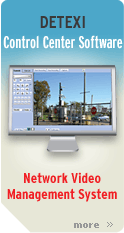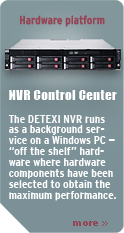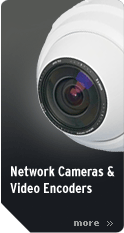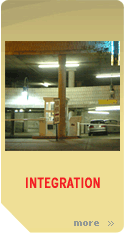- Diagram
- DETEXI System
- DETEXI NVR
- Network Cameras & Video Encoders
- Integration
- Scalability
- Quick Start

|
Video surveillance systems have existed for some 25 years, starting out as 100% analog systems and gradually becoming digitized. Today’s systems have come a long way from the early analog tube cameras connected to a VCR. They now use network cameras and PC servers for video recording in a fully digitized system. Video systems are no longer limited to recording and storing huge volumes of information passively — they can actually evaluate a situation and take action accordingly.
In between the fully analog and the fully digital systems, there are several solutions which are partly digital — these solutions include a number of digital components but do not represent fully digital systems. A video encoder (also called a video server) makes it possible to move toward a network video system without having to discard existing analog equipment. It brings new functionality to analog equipment and eliminates the need for dedicated equipment such as coaxial cabling, monitors and DVRs — the latter becoming unnecessary as video recording can be done using standard PC servers.
|
The DETEXI Network Video Management system, often referred to as DETEXI IP-Surveillance for specific applications within security surveillance and remote monitoring, is a system which gives users the ability to monitor and record video over an IP network — LAN / WAN / Internet.
|

|
This is an on-line guide to setting up an IP-Surveillance in a small, medium, or enterprise level security installation using network cameras and the DETEXI Network Video Management software.
The DETEXI Network Video Management system gives users the ability to monitor and record video and/or audio over an IP (Internet Protocol-based) computer network such as a local area network (LAN) or the Internet.
In a simple IP-Surveillance system, this involves the use of a network camera (or an analog camera with a video encoder/video server), a network switch, and PC with DETEXI software for viewing, managing and storing video. DETEXI software runs as a background service on a Windows PC — off the shelf hardware where hardware components have been selected to obtain the maximum performance.
The core of the DETEXI system is DETEXI NVR — software that supplies the basis for video management, monitoring, analysis, and recording; software that will allow you to, among other things, centrally manage and configure the network video products (network cameras and video servers) to your viewing, recording and security preferences.
DETEXI system offers a single graphical user interface — Remote DETEXI Client — with monitoring, recording, and analysis functionality delivering the timely, accurate information required for effective response to security threats.
Unlike analog video systems that use dedicated point-to-point analog cabling from the camera location to the viewing/recording station, the DETEXI system uses the IP network technology as the backbone for transporting information. In the DETEXI IP-Surveillance application, digitized video and/or audio streams can be sent to any location — via a wired and/or wireless IP network, enabling video monitoring and recording from anywhere with network access.
While an analog video system is for the most part a one-directional signal carrier that ends at the recording device, the DETEXI Network Video Management system is bi-directional — allowing information to be sent and received, and can be an integrated part of a larger, scalable system.
- The DETEXI system, for instance, can send video and audio to a user, as well as receive from the user audio and data instructions that could, for example, activate doors or external alarms.
- In addition, the DETEXI system can communicate with several applications in parallel and perform various tasks such as detecting motion or sending different streams of video.
|
- Using the Remote DETEXI Client part of the DETEXI system, multiple authorized users can access live or recorded video at any time and from any networked location.
- A megapixel network camera can offer resolutions greater than what an analog camera can offer, which means that more detail or larger areas can be covered.
This gives user greater control and management of live and recorded video, as well as alarm events.
There is often too much video recorded and lack of time to properly analyze them. The DETEXI system take care of this by reducing the amount of uninteresting video recorded and enabling programmed responses.
Advanced network cameras have such features as built-in video motion detection, audio detection alarm, tampering detection, I/O connections, and alarm and event management functionalities. These features enable DETEXI System to program and instruct the cameras on —
- when to send video — and at what frame rate and resolution;
- when to activate external mechanisms such as alarms, lights and doors;
- when and how to alert operators;
- where to send video for recording and storage — whether it be local and/or off-site for security purposes.
The intelligent network camera is never idle. It is constantly on guard, analyzing inputs and waiting for an impulse to kick-start an action or series of actions. Intelligence at the camera level enables a more productive and effective means of surveillance. Network bandwidth usage and storage needs are reduced since only actionable information is sent over a network. In addition, less computing power is required from the recording server.
|

|
An IP-Surveillance security installation can be as simple or as sophisticated as your needs require.
Once the network cameras (or analog cameras and video servers, also called video encoders) are installed and configured, you can monitor and record video and/or audio from many cameras simultaneously on a local or remote PC via the Internet using the DETEXI Software.
The DETEXI Network Video Management system is an advanced client/server-based software that provides support for multiple, simultaneous users and thousands of cameras. The core of the DETEXI system — DETEXI NVR, software that supplies the basis for video management, monitoring, analysis, and recording; software that will allow you to, among other things, centrally manage and configure the network video products (network cameras and video servers) to your viewing, recording and security preferences.
The hardware requirements of the DETEXI NVR are not complex — use standard components found in the IT industry.
Today’s PC, with a Pentium processor and Windows operating system, is able to run a video management software, and record and store video from numerous cameras. If the hard disk on the actual server running the recording application is not enough, there are solutions (such as network-attached storage — NAS) that enable you to increase storage space and achieve increased flexibility and recoverability.
DETEXI is an open platform system and have another advantage in that it can be more easily integrated with access control devices, building management systems, industrial control systems and audio. This allows users to manage video and other building controls through a single program and interface. Integrating a video surveillance system with access control systems allows video to be captured at all entrance and exit points.
There are two challenges that video surveillance systems are facing today, namely scalability and reliability. Large organizations that have multiple sites in local or remote locations could have from ten to over a thousand cameras to manage.
The approach in the past was to have islands of standalone systems that required time consuming and inconvenient maintenance and management.
To address scalability and reliability and taking our cue from existing computer network topologies, a new and exciting approach to network video management and control has been developed — the Network Video Recorder Domain model.
Digital video recording consumes a large amount of hard drive storage space. With a large amount of cameras sending information to the NVR over a long period of time, the only way to adequately deal with it is to share the load over a distributed NVR network. The central administration point of this distributed network or domain is the NVR Domain Controller. |
- Camera management — allows users to administer and manage cameras from a single interface. This is useful for tasks such as detecting cameras on the network, managing IP addresses, and setting resolution, compression and security levels. Cameras are often located in distant or hard-to-reach locations, making it impractical for the administrator to visit every location and individually upgrade every camera.
- Simultaneous viewing and recording of live video from multiple cameras — DETEXI enables multiple users to view several different cameras at the same time, and allow recordings to take place simultaneously
- Several recording modes — continuous, on alarm and/or video motion detection, and scheduled (which can combine continuous and on alarm recording instructions)
- Video Motion Detection (VMD) — video motion detection residing in the software, provides VMD functionality to network cameras or video encoders that do not originally embed this feature. This alleviates the workload for any recording devices in the system and makes event-driven surveillance possible. In that case, no video (or only video with low frame rate) is sent to the operator or recording system unless activity is detected in the scene.
- Alarm management functions — for example, parameters can be established so that alarms are not sent during hours of normal activity, such as from 8 a.m. to 9 p.m., Monday through Friday. Therefore, if motion is detected at 3 a.m. on a Saturday, the system knows that this activity is not normal, and can send e-mails or text messages to alert the proper authorities
- Increasing the resolution for cameras with activity or alarms
- Frame rate control — enables users to set the recording frame rate of selected cameras, and pre-determine that if activity is detected, the recording frame rate would increase, and if there is no motion, the rate would decrease
- Full duplex, real-time audio support
|

|
The core components of a network video system: the network camera, the video server (encoder) and video management software.
Network cameras are only ever as good as the selection and configuration of the video management systems that control them. The DETEXI system enables users to monitor, analyze and store video output effectively.
All types of network cameras are available today, and no matter what your needs are, there is a network camera available to meet them. Although analog cameras are available in a similar variety, network cameras can now offer more benefits, including better image quality and greater installation flexibility. For some special applications, such as very high image resolution or wireless needs, network cameras are the only option.
A video encoder (called as well a video server) makes it possible to move toward a network video system without having to discard existing analog equipment. It brings new functionality to analog equipment and eliminates the need for dedicated equipment such as coaxial cabling, monitors and DVRs – the latter becoming unnecessary as video recording can be done using standard PC servers.
DETEXI system allows users to administer and manage cameras from a single interface. This is useful for tasks such as detecting cameras on the network, managing IP addresses, and setting resolution, compression and security levels. DETEXI provides access to every camera on the network. It also allows control of PTZ and dome cameras.
Video Motion Detection (VMD) residing in the DETEXI software, provides VMD functionality to network cameras or video encoders that do not originally embed this feature. This alleviates the workload for any recording devices in the system and makes event-driven surveillance possible. In that case, no video (or only video with low frame rate) is sent to the operator or recording system unless activity is detected in the scene.
The intelligent network camera is never idle. It is constantly on guard, analyzing inputs and waiting for an impulse to kick-start an action or series of actions. Intelligence at the camera level enables a more productive and effective means of surveillance.
|
DETEXI software supports a wide range of network cameras from the world’s leading manufacturers and continues to expand the list. *
* Not all manufacturer models are supported. Contact us directly
for the details.
Image quality is clearly one of the most important features of any camera, if not the most important. This is especially true of security surveillance and remote monitoring applications, where lives and property may be at stake. But how can one guarantee good image quality? That is a
frequently asked question when specifying a new system, which involves sourcing and installing new network cameras.
Once the camera is selected, the next step is to select the appropriate lenses, housings, and any other relevant components necessary in the system. The installer should also be aware of a number of common practices related to camera positioning, which will help in obtaining the best quality out of the system.  Read more in IP Surveillance Design section. |

|
The use of network technology and the integration of mechanical and electronic security solutions is a global trend in the security industry.
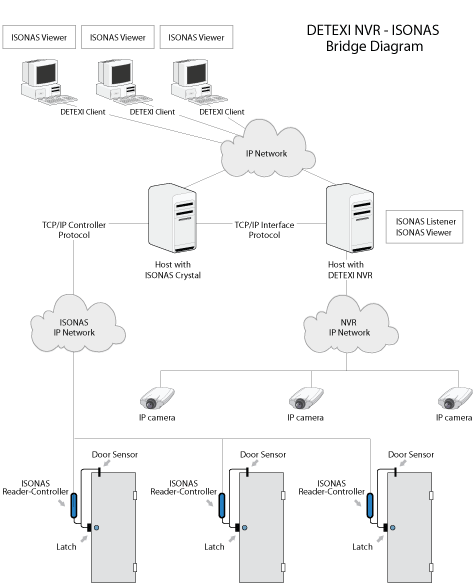
|
The DETEXI Network Video Management system is an open platform system and has another advantage in that it can be more easily integrated with access control devices, building management systems, industrial control systems and audio. This allows users to manage video and other building controls through a single program and interface. Integrating a video surveillance system with access control systems allows video to be captured at all entrance and exit points.
The following devices are presently supported —
|

|
The Internet Protocol (IP) is the most widely used computer communication protocol today. One of the reasons for its popularity — its scalability. In other words, it works as well in very small installations as it does in very large ones and is supported by an increasingly wide range of high-performance, low-cost and industry-proven equipment and technologies.
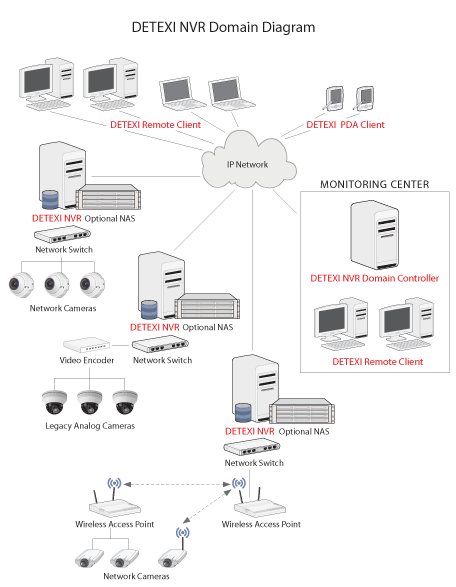
|
An IP-Surveillance security installation can be as simple or as sophisticated as your needs require.
The DETEXI Network Video Management system designed on a network platform is fully scalable. Cameras and licenses can be added one by one and the system hardware can be expanded to meet increased performance requirements. There is no limit to the number of cameras that can be added or managed. This is especially suitable for system scenarios where a large number of cameras are deployed or when the IT department has standard specifications on the server hardware and software allowed on the network.
The DETEXI is an open platform system that also make it easier to add functionality to the system, such as:
- increased or external storage
- firewalls
- virus protection
- intelligent video algorithms.
DETEXI security installation has the ability to scale from small business use to enterprise level security operations. With a number of cameras sending information over a long period of time, the only way to deal adequately with the shear volume of files is to share the load over a distributed NVR network.
NVR network consists of several NVRs that are logically attached to the main NVR — DETEXI NVR Domain Controller. Thus, it is possible to control every NVR remotely from the NVR Controller. Each particular NVR is responsible for its group of cameras and carries the task of recording, touring and alarming functions. NVR Controller learns everything about the NVR’s in the NVR network and their group of cameras.
The DETEXI NVR Domain Controller is the core component for multi-site connectivity. It is indispensable solution for complex distributed environments and monitoring centers.
|

|
Remote viewing, recording and event management
A network camera, unlike a web camera, does not need to be attached to a PC — it operates independently and connects, as with a PC, directly to an IP network. It can be placed wherever there is a network connection. The DETEXI software is specially designed to effectively manage network cameras and video encoders to provide multi-camera viewing, high-quality recording, alarm notification, multi-view playback and remote access capabilities.

 Save and unzip

 DETEXI software installation, registration
 Min hardware requirements
 NVR & Client Configuration
|
|
|
Once you have made an assessment of your needs, choose a network camera. Not all network cameras are created equal. A key determinant of a network camera is image quality. When assessing image quality, be sure to consider a network camera’s light sensitivity, the crispness of moving objects and the level of clarity. Read through a camera’s datasheet and, most importantly, field test a few cameras before making a decision. Find out if the network camera is able to work with the DETEXI software —
Before you set out to order or buy many network cameras, it is a good idea to buy one and test its quality. Try out a network camera with a demo version of DETEXI software, which is downloadable here. DETEXI demo version provides simultaneous viewing and recording of high-quality video from network cameras. When the DETEXI NVR is first installed, it will be in demo mode for 30 days. For installation instructions, refer to the Installation section of this guide.
After installing the software, it must be configured for your cameras and video encoders. This guide describes how to configure and maintain the DETEXI NVR and Remote DETEXI Client as well as how to set up recording, motion detection, and alarms.
|
|

 DETEXI® Network Video Management System
DETEXI® Network Video Management System


 DETEXI® Network Video Management System — represents an entirely new approach to remote monitoring, offering significant cost and operational benefits over its analogue predecessors.
The DETEXI monitoring solutions unify all your video, access control, and alarm management functionality into one Command and Control Center and create actionable information based on analyzing alarm and event inputs.
DETEXI® Network Video Management System — represents an entirely new approach to remote monitoring, offering significant cost and operational benefits over its analogue predecessors.
The DETEXI monitoring solutions unify all your video, access control, and alarm management functionality into one Command and Control Center and create actionable information based on analyzing alarm and event inputs. 

